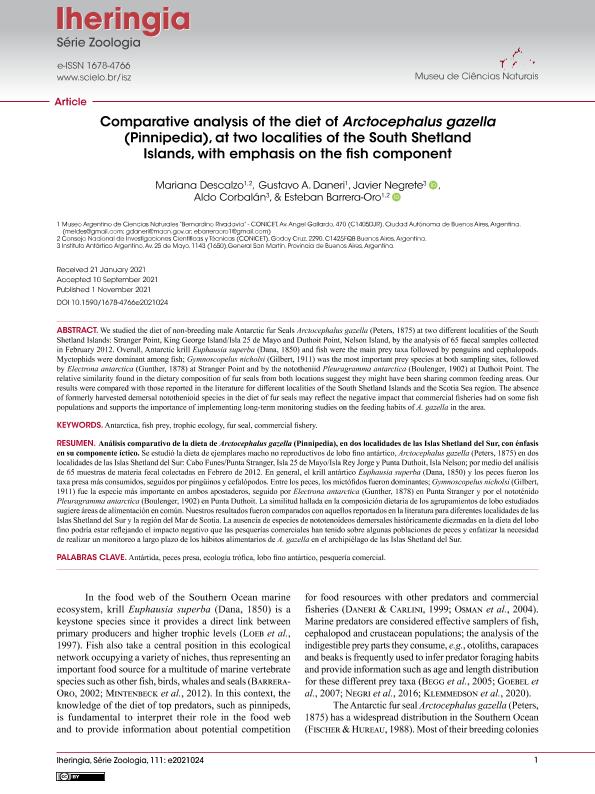Artículo
Se estudió la dieta de ejemplares macho no reproductivos de lobo fino antártico, Arctocephalus gazella (Peters, 1875) en dos localidades de las Islas Shetland del Sur: Cabo Funes/Punta Stranger, Isla 25 de Mayo/Isla Rey Jorge y Punta Duthoit, Isla Nelson; por medio del análisis de 65 muestras de materia fecal colectadas en Febrero de 2012. En general, el krill antártico Euphausia superba (Dana, 1850) y los peces fueron los taxa presa más consumidos, seguidos por pingüinos y cefalópodos. Entre los peces, los mictófidos fueron dominantes; Gymnoscopelus nicholsi (Gilbert, 1911) fue la especie más importante en ambos apostaderos, seguido por Electrona antarctica (Gunther, 1878) en Punta Stranger y por el nototénido Pleuragramma antarctica (Boulenger, 1902) en Punta Duthoit. La similitud hallada en la composición dietaria de los agrupamientos de lobo estudiados sugiere áreas de alimentación en común. Nuestros resultados fueron comparados con aquellos reportados en la literatura para diferentes localidades de las Islas Shetland del Sur y la región del Mar de Scotia. La ausencia de especies de nototenoideos demersales históricamente diezmadas en la dieta del lobo fino podría estar reflejando el impacto negativo que las pesquerías comerciales han tenido sobre algunas poblaciones de peces y enfatizar la necesidad de realizar un monitoreo a largo plazo de los hábitos alimentarios de A. gazella en el archipiélago de las Islas Shetland del Sur. We studied the diet of non-breeding male Antarctic fur Seals Arctocephalus gazella (Peters, 1875) at two different localities of the South Shetland Islands: Stranger Point, King George Island/Isla 25 de Mayo and Duthoit Point, Nelson Island, by the analysis of 65 faecal samples collected in February 2012. Overall, Antarctic krill Euphausia superba (Dana, 1850) and fish were the main prey taxa followed by penguins and cephalopods. Myctophids were dominant among fish; Gymnoscopelus nicholsi (Gilbert, 1911) was the most important prey species at both sampling sites, followed by Electrona antarctica (Gunther, 1878) at Stranger Point and by the nototheniid Pleuragramma antarctica (Boulenger, 1902) at Duthoit Point. The relative similarity found in the dietary composition of fur seals from both locations suggest they might have been sharing common feeding areas. Our results were compared with those reported in the literature for different localities of the South Shetland Islands and the Scotia Sea region. The absence of formerly harvested demersal notothenioid species in the diet of fur seals may reflect the negative impact that commercial fisheries had on some fish populations and supports the importance of implementing long-term monitoring studies on the feeding habits of A. gazella in the area.
Análisis comparativo de la dieta de arctocephalus gazella (Pinnipedia), en dos localidades de las islas Shetland del sur, con énfasis en su componente íctico
Título:
Comparative analysis of the diet of arctocephalus gazella (Pinnipedia), at two localities of the south Shetland Islands, with emphasis on the fish component
Fecha de publicación:
11/2021
Editorial:
Fundaçao Zoobotanica Rio Grande Sul
Revista:
Iheringia. Série Zoologia
ISSN:
0073-4721
e-ISSN:
1678-4766
Idioma:
Español
Tipo de recurso:
Artículo publicado
Clasificación temática:
Resumen
Palabras clave:
ANTARCTICA
,
COMMERCIAL FISHERY
,
FISH PREY
,
FUR SEAL
,
TROPHIC ECOLOGY
Archivos asociados
Licencia
Identificadores
Colecciones
Articulos(MACNBR)
Articulos de MUSEO ARG.DE CS.NAT "BERNARDINO RIVADAVIA"
Articulos de MUSEO ARG.DE CS.NAT "BERNARDINO RIVADAVIA"
Citación
Descalzo, Mariana; Daneri, Gustavo Adolfo; Negrete, Javier; Corbalán, Aldo; Barrera Oro, Esteban; Análisis comparativo de la dieta de arctocephalus gazella (Pinnipedia), en dos localidades de las islas Shetland del sur, con énfasis en su componente íctico; Fundaçao Zoobotanica Rio Grande Sul; Iheringia. Série Zoologia; 111; 11-2021; 1-7
Compartir
Altmétricas




